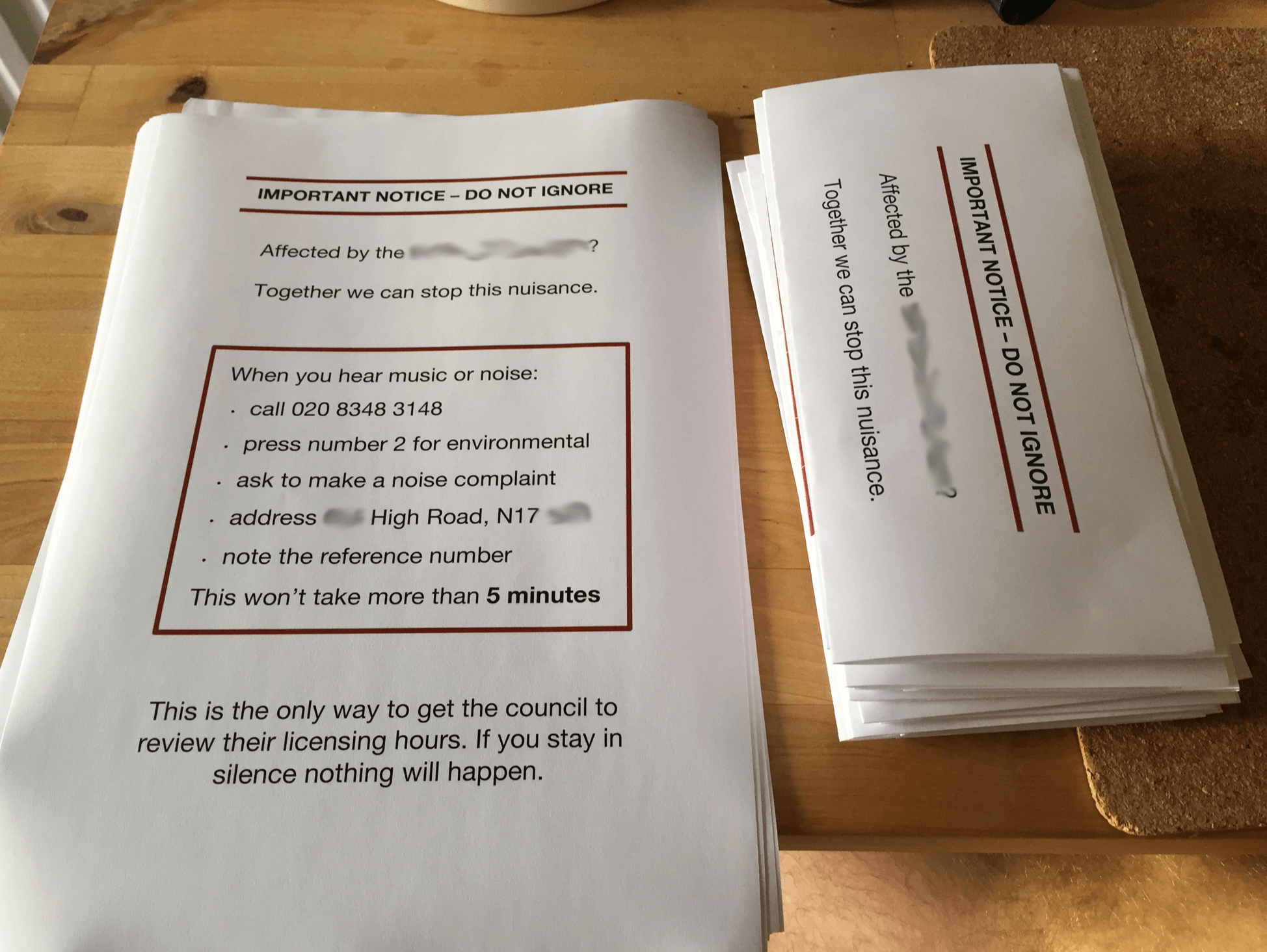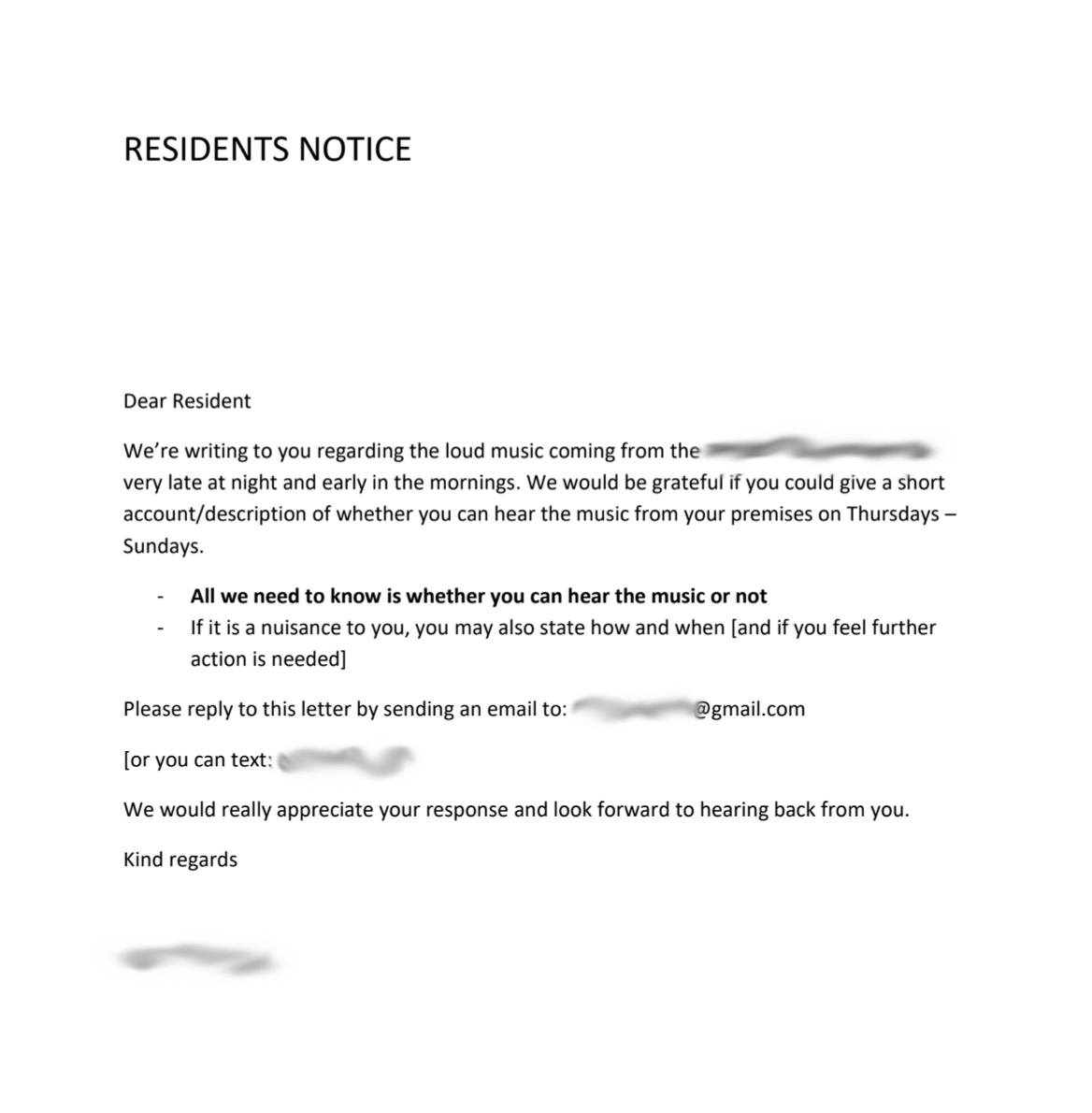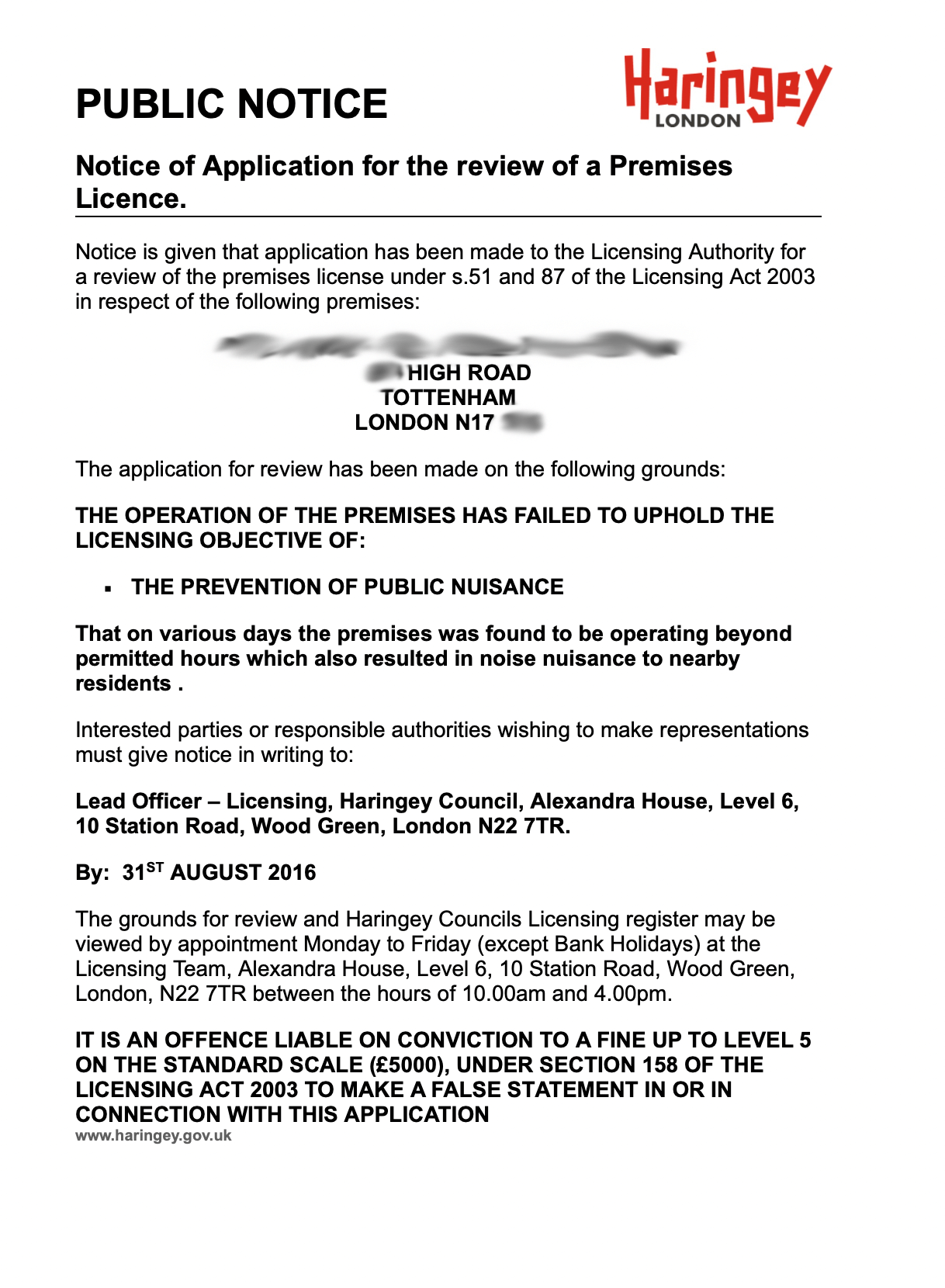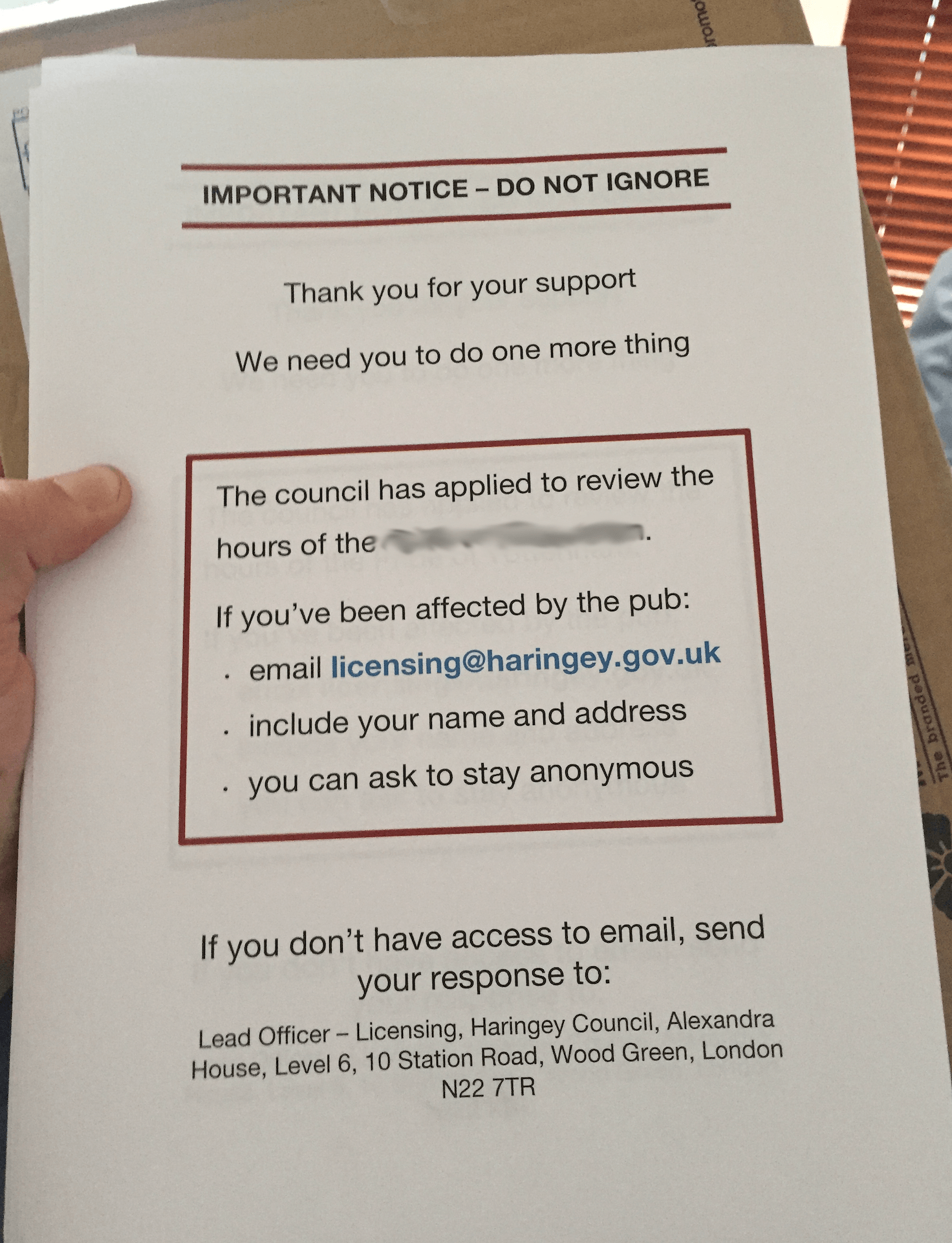
Local change, through design
Date: 07 April 2022
This is a fairly personal story. It’s been more than eight years since the ordeal started – I have been meaning to write about it for a long time!
At the end of 2021, I read “The agile comms handbook” which prompted me to finally get this out there. Hopefully it helps somebody, but I mainly wanted to jot it down before I forget. Maybe there are things that I would do differently if I was doing this today, but I think a lot of the principles still stand.
This is a story about how I used the things I’ve learnt as a designer (mainly in the public sector) – writing in plain language and meeting people’s needs – to get a resolution to an issue that affected me personally. I have redacted the name of the pub, but all of this information is publicly available in Haringey Council’s archive.
In July 2014 my wife and I bought a flat in Tottenham. It was diagonally opposite a pub… We were 25 years old and naive. The flat was big, in an otherwise amazing (up-and-coming) location, with great transport links and local shops on the doorstep.
In short, we didn’t do enough research around the pub. We looked at the opening times (7am till 4am, Friday to Sunday). “That can’t be right” we said to each other, “Google Maps must have that down wrong”. Lesson well and truly learnt – if you’re buying a property near a pub, visit at night and don’t take people’s word for it (if they say it’s not an issue).

Fast forward to September 2014. The start of a long string of emails, phone-calls and visits with Haringey Council. Google Maps wasn’t wrong. The pub indeed had a licence until 4am – it effectively acted as a nightclub, with punters arriving at midnight and leaving usually well into the morning. This included Sunday nights… in a heavily residential area.
We were kept up every night at the weekend, with loud bass music and the general noise that goes with that. We would ring up and complain, the council would turn up, the music would stop and then start again 20 minutes later. We sent countless emails to the council. Nothing worked. My wife even tried speaking to the owner – “we’ve never had any complaints” he said.
Our failed attempt at a solution
In December that year, we tried drafting a “residents letter”. We printed out 50 copies, put them in envelopes and dropped them into as many nearby properties as possible. The letter included an email address which we created to receive – the idea being to gain a critical mass of people and go to the council together.

We received one reply.
“Yes, I can hear loud music and it keeps me up most nights … Can you please find a solution for this as it is becoming extremely irritating”.
We had failed. Looking at this letter there were a number of issues:
- it was in an envelope with the window just saying “RESIDENTS NOTICE” – most people probably didn’t even open it
- we asked for people to come forward and effectively “show their face”, without knowing the history and that people were scared to be seen to complain
- it was overly wordy and not easily scannable
- we didn’t actually say what the plan was (to be fair, I don’t think we really had one)
Now what? This was seriously affecting our lives, our work and our relationship. We had to put a mattress in our living room and take turns sleeping in there to get away from the noise. We had heard that people left the area because of this pub. Should we sell too? Who would even buy the flat?
For the next year or so we spent a lot of the time away from the flat, working on different projects. I then started to get more experience in what “good content design” means. I realised we had been looking at this issue from the wrong angle. I wondered, what would I do if I was trying to solve this kind of issue for a client?
Using design principles
In July 2016 I designed a new leaflet-style letter. This time rather than getting the residents to try and contact me, I thought “why not try and make it easier for people to contact the council?”.

The leaflet used a few principles, it:
- used plain language and a large, clear font – this had the added effect that it kind of looks a bit like a government letter and maybe “official”
- included (what I’ll now call) a “lure” - thanks @gilest - a succinct call-to-action which would appear on the front of the leaflet, with the paper divided in thirds
- used language to make them feel like they weren’t alone
- met the user need to remain anonymous - the owner of the pub was intimidating and a lot of the residents didn’t want to have to encounter him
- set expectations - telling people what would happen when they called the council and gave them some key information to make the call more efficient
- told them what would happen if they did nothing – giving them more impetus to take action
This time, we didn’t put the leaflet in an envelope and we dropped them into as many letterboxes as possible at 6am on a Saturday morning. We knew the pub was likely to be loud that evening so hopefully the letter would still be fresh in people’s minds as the noise started.
Sure enough, the music started at around midnight, so I called the council. The response was pretty overwhelming.
“there’s no need for me to come out - we’ve had 12 calls this evening already - I’ll be launching a review of the pub’s hours”.
The leaflet worked! After almost two years, we were suddenly optimistic about the situation. Although I had no idea about what a review entailed. It turned out to be another 7 months of pain.

People don’t notice council notices
Unless you’ve ever been affected by them, you’ve probably never taken a second look at council public notices. Whether they are for planning permission (or in this case a review of a licence), council notices are usually A4 pieces of paper stuck to a lamppost.
They contain absolutely loads of information, horrendously formatted and they usually only offer a postal address as a way of responding. I saw the notice of the review of the hours pinned to the lamppost outside the pub and thought “there is no way anybody is going to see that, let alone respond to it”.
Round two
Let’s try another leaflet. Using the same principles as the successful leaflet that brought about the review, I designed another one to provide an easy way for residents to respond to it. I found out from the council that actually you can email them your response, so I included that as the primary way of responding and had the address as a secondary way for people without access to email to respond. We dropped the final leaflet into letterboxes in August 2016.

It had 13 responses from residents, with heartbreaking accounts of how the pub had affected so many lives. From a disabled, dyslexic man who lived alone – sometimes unable to access his house on his crutches because of cars blocking the entrance. To a single mother living with 4 children, having to step over excrement on their way to school on a Monday. These people previously felt helpless because of how inaccessible the council had made the whole process.
That September I attended a hearing at the council. I was the only resident willing to lose anonymity to give my account of the issues, but backed up by the overwhelming responses from other local residents. It was over pretty quickly. On 15 September the hours were set to more fitting hours for a pub – 23:30 on weekdays and 00:30 Fridays and Saturdays.
We thought that was that. But the weekend came and the noise started again. I called the council – the owner had appealed the decision. Unbelievably, a premises has the right to appeal a review of its hours and until that appeal is heard it can keep its existing hours. The months dragged on and I was told a date had been set – February 2017.
The next few months were tortuous but there was at least an end in sight. I attended Highbury Magistrates’ court to give my evidence. The decision was upheld and the pub was sold. It is now a beautiful gastro pub run by responsible owners and it is absolutely thriving (without the need to be a nightclub).
We no longer live in Tottenham, but we’re confident that the whole area is better off because of this change. Only made possible through good design.